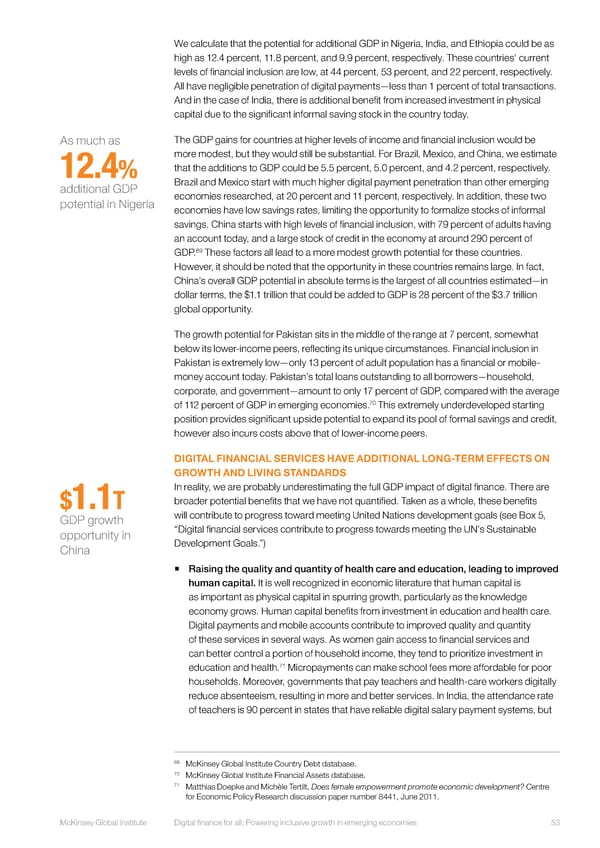We calculate that the potential for additional GDP in Nigeria, India, and Ethiopia could be as high as 12.4 percent, 11.8 percent, and 9.9 percent, respectively. These countries’ current levels of financial inclusion are low, at 44 percent, 53 percent, and 22 percent, respectively. All have negligible penetration of digital payments—less than 1 percent of total transactions. And in the case of India, there is additional benefit from increased investment in physical capital due to the significant informal saving stock in the country today. As much as The GDP gains for countries at higher levels of income and financial inclusion would be more modest, but they would still be substantial. For Brazil, Mexico, and China, we estimate 12.4% that the additions to GDP could be 5.5 percent, 5.0 percent, and 4.2 percent, respectively. additional GDP Brazil and Mexico start with much higher digital payment penetration than other emerging potential in Nigeria economies researched, at 20 percent and 11 percent, respectively. In addition, these two economies have low savings rates, limiting the opportunity to formalize stocks of informal savings. China starts with high levels of financial inclusion, with 79 percent of adults having an account today, and a large stock of credit in the economy at around 290 percent of 69 GDP. These factors all lead to a more modest growth potential for these countries. However, it should be noted that the opportunity in these countries remains large. In fact, China’s overall GDP potential in absolute terms is the largest of all countries estimated—in dollar terms, the $1.1 trillion that could be added to GDP is 28 percent of the $3.7 trillion global opportunity. The growth potential for Pakistan sits in the middle of the range at 7 percent, somewhat below its lower-income peers, reflecting its unique circumstances. Financial inclusion in Pakistan is extremely low—only 13 percent of adult population has a financial or mobile- money account today. Pakistan’s total loans outstanding to all borrowers—household, corporate, and government—amount to only 17 percent of GDP, compared with the average 70 This extremely underdeveloped starting of 112 percent of GDP in emerging economies. position provides significant upside potential to expand its pool of formal savings and credit, however also incurs costs above that of lower-income peers. DIGITAL FINANCIAL SERVICES HAVE ADDITIONAL LONG-TERM EFFECTS ON GROWTH AND LIVING STANDARDS In reality, we are probably underestimating the full GDP impact of digital finance. There are $1.1T broader potential benefits that we have not quantified. Taken as a whole, these benefits GDP growth will contribute to progress toward meeting United Nations development goals (see Box 5, opportunity in “Digital financial services contribute to progress towards meeting the UN’s Sustainable China Development Goals.”) ƒ Raising the quality and quantity of health care and education, leading to improved human capital. It is well recognized in economic literature that human capital is as important as physical capital in spurring growth, particularly as the knowledge economy grows. Human capital benefits from investment in education and health care. Digital payments and mobile accounts contribute to improved quality and quantity of these services in several ways. As women gain access to financial services and can better control a portion of household income, they tend to prioritize investment in 71 Micropayments can make school fees more affordable for poor education and health. households. Moreover, governments that pay teachers and health-care workers digitally reduce absenteeism, resulting in more and better services. In India, the attendance rate of teachers is 90 percent in states that have reliable digital salary payment systems, but 69 McKinsey Global Institute Country Debt database. 70 McKinsey Global Institute Financial Assets database. 71 Matthias Doepke and Michèle Tertilt, Does female empowerment promote economic development? Centre for Economic Policy Research discussion paper number 8441, June 2011. McKinsey Global Institute Digital finance for all: Powering inclusive growth in emerging economies 53
 DIGITAL FINANCE FOR ALL Page 66 Page 68
DIGITAL FINANCE FOR ALL Page 66 Page 68